Blog
Vintage Speakers, Modern RELs
How using a modern REL with vintage speakers can make for a great system
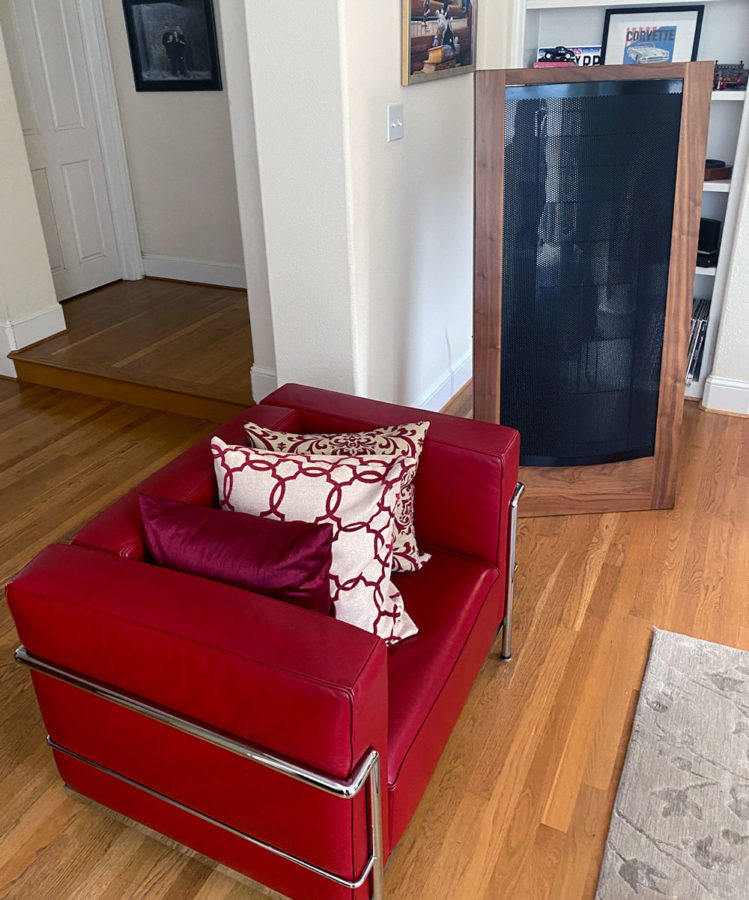
Like many during COVID, I turned to passions that brought me great joy at a time when so many personal freedoms had been stripped away. For myself, it gave me time to research and purchase some older vintage hi fi gear. A quick aside; one of the characteristics that has helped keep REL firmly on track these past 16 years has been a very accurate aural memory, closely linked to an experiential memory not unlike an elephant’s. If something done years ago sounds great in my memory, my mind doesn’t guild the lily and, I am able to retain a solution a mentor shared with me 20-30 years ago and, when executed with modern parts or updated technique. It serves just as well to solve a problem today as in yesteryear.
In part out of a sense of professional curiosity I have (mostly) limited my purchases to vintage speakers. While this is not a piece that attempts to review speakers of the ‘80’s and ‘90’s my journey may coincide with some of your interests so I thought I’d share with you some of my findings, though this may piss off some of those making modern speakers. I ran them with, no surprise, a variety of RELs both vintage and modern. I was struck by, and many of you may well be too, by two things: 1) How amazing the speakers of yesteryear (listed below) hold up when run with highly resolved modern sources, electronics and cables, and 2) Modern RELs. It’s surprising given how much has advanced in the loudspeaker art—drivers are hugely advanced and the revolution in passive components began in earnest only in the late ‘80’s. Yet, like signature meals prepared by master chefs, these don’t disappoint.
I was struck by how slow vintage subwoofers of the day were, even ours. I used a REL Storm III I have owned and was still new in the box, as well as a REL Studio II from the late ‘90’s.
The best speaker designs of the past, those that were, perhaps, a bit (to a lot) ahead of their time stand up well to modern efforts. Here are some of my purchases:
Sequerra Met-7
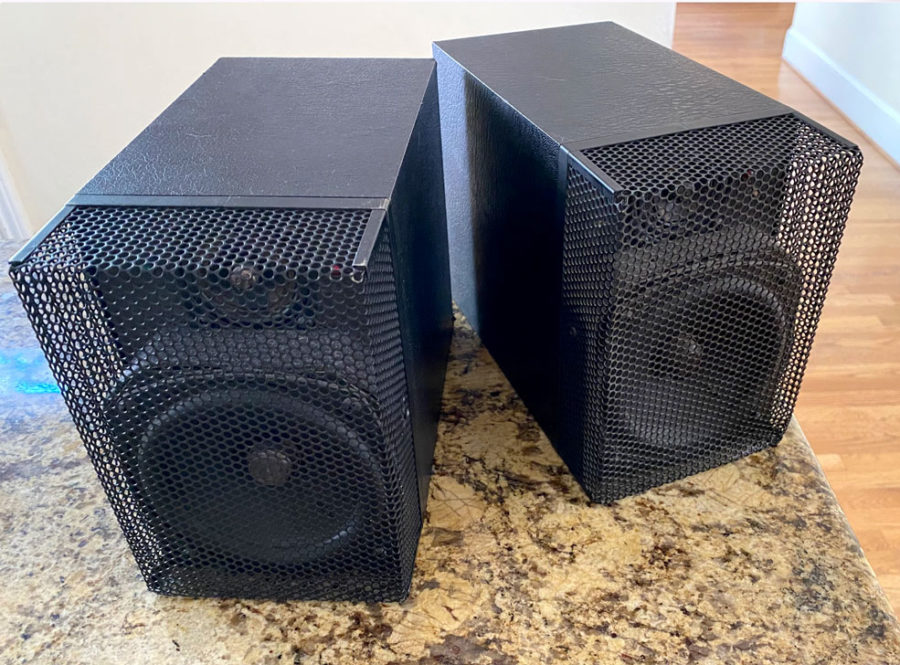
First up is a tiny and still inexpensive speaker that was, in its time from early ‘80’s to mid-90’s, a cult classic. The Sequerra Met 7 sold for the princely sum of $305 in 1983, might have been a selectee for the Museum of Modern Art so pure and unadulterated is its form.
Dick Sequerra loved modern design and yes, for those who wonder, he designed the Sequerra tuners that are the stuff of legend. I bought a pair in slightly rough condition (most are rough, so look carefully at pictures on eBay), had to hand tap out several dents in the grilles and had to reglue one cabinet where it had split along a seam. Sonically, then as now, it delivered essentially NO bass dropping out by 70 Hz or so. But oh my, from 70 clean Hz up to around 12,000 cycles they get to the midrange truth as well as many speakers costing $5,000 or more today. Push them hard and LEDs will light up, green initially letting you know you’re properly getting your groove on, Red to let you know you’re about to gush $305 worth of confetti into your room.
They were designed to be the midrange module for a system that included stereo subwoofers and ribbon tweeters, so they weren’t tasked with trying to do too much. Met-7’s have a purity of delivery that lets one connect with music in an unvarnished, truthful manner too few modern speakers supply.
I coupled them with an exotic new subwoofer prototype [mL1] that extends so deep and hits so hard it’s been hard work running around fixing rattles in our home, but that’s another story. Everyone who hears them marvels at their sound quality, fed by nothing more exotic than a modern Yamaha RS-202 receiver that sells for under $200 in America.
Martin Logan CLS
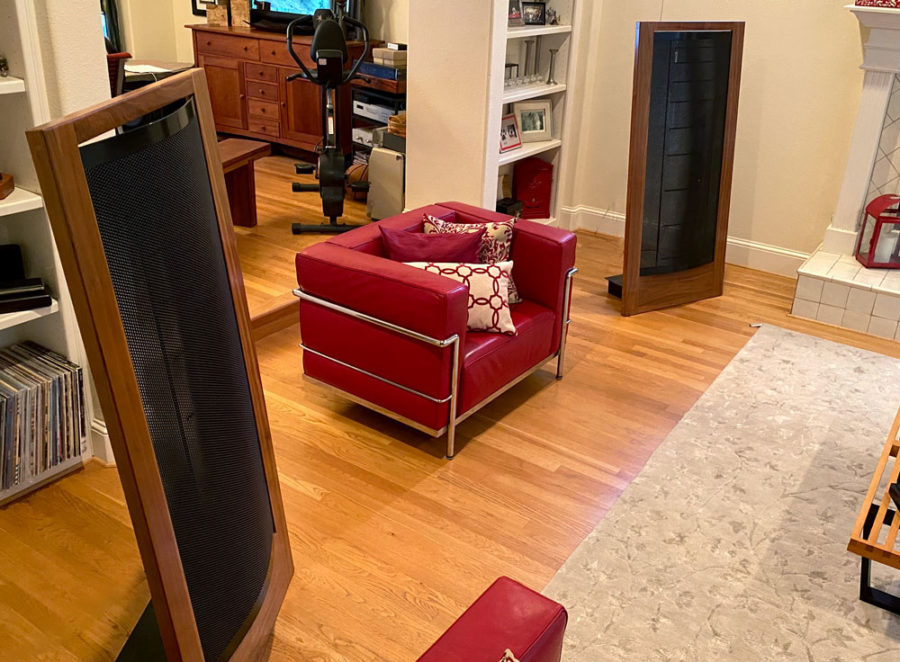
This speaker, a 1986 pair according to the serial numbers, is for those of us who know Gayle Sanders and admire his combination of unfailingly perfect aesthetic instincts and savvy speaker design, this model is the pinnacle of his work. Now, I have yet to listen under controlled circumstances to the CLS II or CLAS IIZ that followed it, folks have all sorts of opinions about which version is the best. Those folks miss the point, they’re likely all amazing.
Instantly you realize they’re utterly gorgeous. Mine, a walnut pair, stop conversations as soon as people realize they’re a speaker. Don’t blame them. A completely see-through, curved transparent electrostatic panel whose high voltage drive is supplied by curvilinear black perforated screens housed in a simple wooden frame; 34 years on they remain pure design reduced to its absolute minimum. They are also a beautifully fast, liquid and as the name implies (CLS is an acronym for Coherent Line Source) a coherent marvel of an electrostat.
On their own, they have a slightly hooded quality, the result of the rear side of the curved panel resonating in the frame’s boundary. They also don’t make a lot of deep bass but go deeper than many claim. Mine consistently deliver around 52 Hz which is deep enough to get most kickdrums spot on. Here’s the real trick that takes them from fascinating to world class; when partnered with a Line Array of REL S/510’s every shortcoming we knew they had back in the day evaporates. Suddenly, they sound like a slightly reduced-scale version of Infinity IRS V’s, those 8’ tall winged behemoths of the ‘80’s that featured 12 x 12” subwoofer towers and forests of ribbon drivers and threw the most convincing soundstages, some believe, ever. But the CLS/S510 combination delivers this magic in the kind of rooms real people own. Our development studio is roughly 15’ x 23’ and this combination staggers all who’ve heard it. And plays as loud as most folks can stand.
You heard me right, when hard pushed on their own, they struggle to deliver wallop. Yet everyone who’s heard this combination marvels at their sound, at the sheer rightness of it all and it delivers big symphonic and close-mic’d kick ass rock as well as pretty much any great speaker I’ve heard in the past 30 years.
KEF Reference 101’s
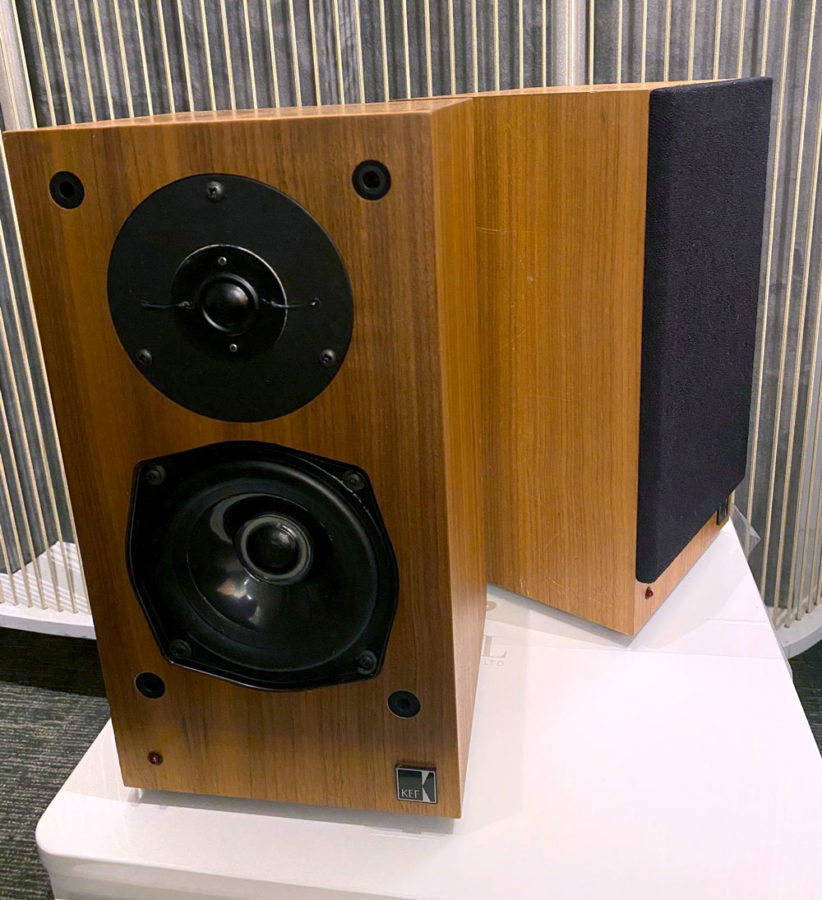
The real ones from the ‘80’s, not the mediocre effort that marketing waved the name over in the ‘90’s in a lame attempt to sprinkle fairy dust over a middling hash of a speaker 15 years later. Ever heard of a speaker called generically, an LS3/5a? It’s pretty much required reading and every serious student of the hi fi arts feels compelled to genuflect in their presence.
Developed for the BBC in the relatively early days of live television, often used as location monitors bolted to the bulkhead of a tiny Ford van, these miniature marvels became legendary when the BBC licensed production to a number of British specialty speaker firms. Names like Rogers, Spendor, Chartwell and many more. All these various efforts had one thing in common. ALL drivers were sourced from KEF and featured a 1” polymer dome tweeter called the T-27 mated to a 4 1/2″” bextrene (a lightweight, stiff plastic) mid-woofer known as the B-110. If we’re being truthful and not looking at the world through paisley-framed rose-tinted glasses, they also all suffered from a bump in the upper-middle bass, around 58 Hz, and similarly sparkled in the brightness region. It was all good fun, mind, but surely not the last word in accuracy.
Where the KEF 101’s diverged was in several significant upgrades. Firstly, the obvious, they made every driver ever used in LS3/5a’s by licensees, but they saved their best work for themselves. KEF Reference drivers in the Model 101’s had unique surrounds that permitted extra-long throw, allowing 101’s to deliver superior dynamics. Similarly, the T-27’s used were lower distortion and squeaked out just a little greater volume from their gorgeous cabinets which, themselves, were just a little larger volume than standard 3/5a’s. Finally, they featured a brilliant protection network that, should their owners push them a bit too hard, would first allow a SNAP! to be heard (without damage) as a warning and if you insisted on being a hooligan, would interrupt the sound as if to say, “That’s enough, knock it off.”
Nothing against all forms of LS3/5a’s they’re all wonderful, good fun. But one day back when they were still in production, a couple of us recorded a friend who was a hell of an acoustic guitarist, then played it back at identical levels comparing a pair of Rogers LS3/5a against the 101’s. The Rogers did the LS3/5a thing, turned his guitar into a lively bouncing thing that was great fun to listen to. And then we switched over to the KEF 101’s. Two notes in, it was game, set and match. The KEFs didn’t sound better than, better than or make it sound any different than the custom-built hand-made monster of a guitar that it actually was. There was Richard’s fingering, the rich resonant body and sustain of the Brazilian rosewood top, the clear metallic top strings that were so obviously phosphor bronze. Just him and his guitar. Just.
If you’re sad you missed out on the LS3/5a thing (clean models now run $2,000-3,500) buy yourself a pair of KEF 101’s before word gets out. As I write this, they run around $600-800/pair in the US, less in the UK where Rogers et al command princely sums. I’m still messing around with stands but will fill you in as soon as I am ready to call out something special. They benefit from taller height stands than were often used with small monitors back when they were new. Somewhere in the 26”-28” range should work well but, as always, listen and use your own judgement. Ceilings that are low will affect this, forcing you to use a lower stand. And you’ll need a solid 75–100 watts of high current power to make them come alive (no 3/5a’s are efficient). But if you know what live music sounds like, especially small ensembles and you’re not asking it to play at 104 db, you would be hard pressed to find a better solution. I used them with a pair of T/7x and plan to never sell mine. I also tried them with my old Studio II, which wound up feeling somewhat like driving the kids to school in a mid-90’s Bentley Turbo must have. Way too much of something good, unnecessary and a little vulgar, but great fun.
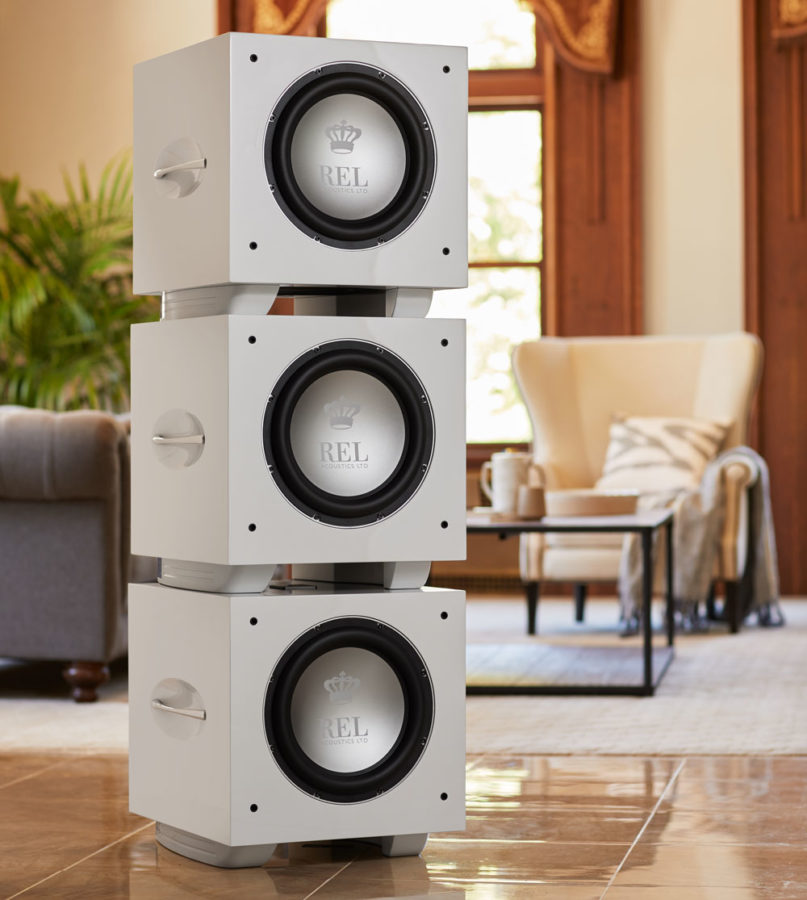
I was frankly surprised by the overall quality and qualities delivered by these speakers. I don’t know what I expected, but I didn’t expect them to keep up with modern speakers. Certainly not modern speakers costing 5–10 times what these do at current market prices. Were the Martin Logans CLS to be reissued and–here’s the catch–supported by a world class team of hi fi Gods who could set them up brilliantly and demonstrate what they were capable of when paired with a 6-pack of REL S/510’s, that ensemble would put every current $30,000 speaker pair extant on the trailer. Period. The Sequerra Met-7 is the most controversial speaker here, due to their ultimate lack of output which, for some, will render them inadequate. But, bolstered by a fast modern REL (I’d pair them with a T/ 7x as the 7x releases bass in a cleaner, faster manner than the 5x) these could do significant damage to most any $4-5,000 pair of speakers.
And then there is the KEF 101. Why history has overlooked this speaker is an open question. I believe it was partly/largely down to two things. First, KEF in the ‘80’s held the same status B&W have for the past 20 years. Both seen to be giants in a world of small, specialty firms. It’s always easy to cheer for David, yet sometimes a staff of world class engineers headed up by a legitimate audio God (Laurie Fincham is a name too few of you know and you should, I’d like to do a series of interviews of this fascinating, frank and funny man and publish them on YouTube. Let me know if you’d like us to do this) simply ARE better. Also, the cute little bump in the bass and added sparkle in the brightness range are addictive, but ultimately become obvious. The KEF Reference 101 delivers near world class monitor sound, a touch opaque by modern standards of transparency, and like 3/5a’s everywhere, not the speaker for fans of Def Leppard but fully capable of becoming a lifetime companion.
My final takeaway was how wonderfully satisfying partnering these several examples of vintage excellence with modern RELs has been. The vintage experience is not to be taken lightly as it does require significant knowledge to allow one not to get burned. The safest bet here would be the KEF 101’s as they offer that fast protection network that catches most accidental acts of stupidity, whereas the CLS could run you well over $2,000 to install replacement panels and the Met-7’s would simply go up in flames if seriously overdriven. As I reflect back on this experience, it makes me wonder if we shouldn’t produce a truly world class powered pair of RELs that would double as speaker stands for the old LS3/5a crowd. Cheers!











